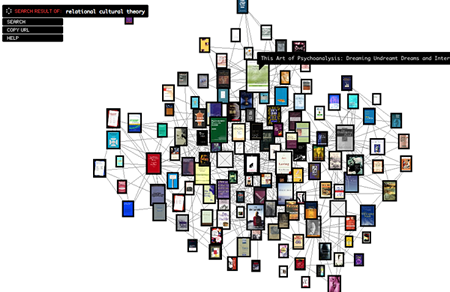There is a well-designed search tool called Amaznode that leverages the Amazon.com recommendations to visualize how search results relate. I came across this while exploring interesting visualizations (). The tool is a personal project by that started in 2004, was thwarted by existing Flash technology, and last year was renewed by creator Takayuki Fukatsu when that tech caught up. Fukatsu worked for the Japanese company, Tha.
Try searching for HCI Design, informatics, parenting, fantasy sports, relational-cultural theory, complex systems, online community, politics and Bloomington, Indiana. These are areas of interest to our blog. In most cases, the reading list that emerges from this tool is both incomplete and somewhat inaccurate, in the sense that it doesn’t match how we might interpret our own search terms. Informatics, for example, is very health-centric, which is a reflection on the word having more attachment to that area than chemistry, music, sociology or computers. Fantasy sports has a similar problem, with too much Harry Potter and romance novels in the mix. However, the network presentation of these makes it pretty easy to explore the hubs and find a relevant area.
According to Takayuki, the main logic of a spring network involves (a) the spring, (b) repulsion, and (c) a sense of gravity. The springs are special visualizations of the edges in the network, keeping two items at a proper distance from each other as things move around. The items themselves repulse other items, to avoid a bunch of books showing up on top of each other. The screen itself is supposed to have a center of gravity, keeping the nodes contained in the display area, but on my small MacBook monitor I have some issues with large search results sending items out of the visible area. I can drag them back in, but only if they are attached to items that are visible.
There is more information about Amaznode available online, though no real plans to monetize it (beyond the default affiliate ID in the code) or release the tool (though possibly the API or spring engine). Takayuki also has a few other neat creations to play with.
This is relevant for some other research going on at the IU School of Informatics () and my interest improving wiki/forum navigation. The Visual Thesaurus first started doing this stuff almost a decade ago using an SDK by ThinkMap. I’d love to play with that technology, but the starting price for the Standard edition is about $10,000. There is a desktop version of the Visual Thesaurus available for about $40, but it performs a very specific function.

1 reply on “Amaznode”
Some follow-up after contacting Takayuki …
* del.icio.us shows some 466 bookmarks to Amaznode, as of today
* Takayuki doesn’t make any money off of Amaznode, but he does get the fringe benefits of having it as a portfolio piece (conversations, jobs, writing gigs, etc)